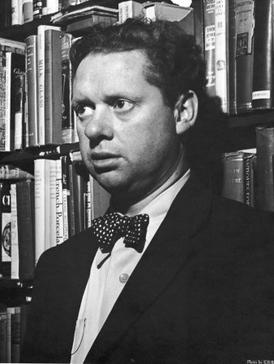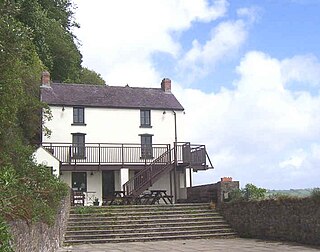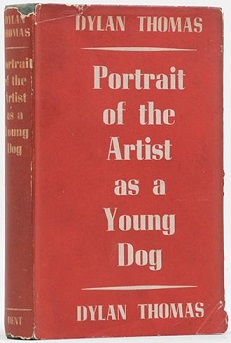Related Research Articles

Dylan Marlais Thomas was a Welsh poet and writer whose works include the poems "Do not go gentle into that good night" and "And death shall have no dominion", as well as the "play for voices" Under Milk Wood. He also wrote stories and radio broadcasts such as A Child's Christmas in Wales and Portrait of the Artist as a Young Dog. He became widely popular in his lifetime; and remained so after his death at the age of 39 in New York City. By then, he had acquired a reputation, which he had encouraged, as a "roistering, drunken and doomed poet". Dylan Marlais Thomas was the son of David John Thomas, a school master, and Florence Hannah Williams who married in 1903 and were living in Sketty Avenue, Sketty, Swansea when the 1911 Census was taken. Their daughter Nancy, born 1906, was not at home with them on Census Day.
Under Milk Wood is a 1954 radio drama by Welsh poet Dylan Thomas. The BBC commissioned the play, which was later adapted for the stage. The first public reading was in New York City in 1953.

"Do not go gentle into that good night" is a poem in the form of a villanelle by Welsh poet Dylan Thomas (1914–1953), and is one of his best-known works. Though first published in the journal Botteghe Oscure in 1951, the poem was written in 1947 while Thomas visited Florence with his family. The poem was subsequently included, alongside other works by Thomas, in In Country Sleep, and Other Poems and Collected Poems, 1934–1952. The poem entered the public domain on 1 January 2024.

New Quay is a seaside town, community and electoral ward in Ceredigion, Wales; it had a resident population of 1,045 at the 2021 census. Located 19 miles (31 km) south-west of Aberystwyth, on Cardigan Bay with a harbour and large sandy beaches, the town lies on the Ceredigion Coast Path and the Wales Coast Path. It remains a popular seaside resort and traditional fishing town, with strong family and literary associations with the poet Dylan Thomas and his play, Under Milk Wood.

Laugharne is a town on the south coast of Carmarthenshire, Wales, lying on the estuary of the River Tâf.

Dame Elizabeth Violet Maconchy LeFanu was an Irish-English composer. She is considered to be one of the finest composers Great Britain and Ireland have produced.
"And death shall have no dominion" is a poem written by Welsh poet Dylan Thomas (1914–1953). The title comes from St. Paul's epistle to the Romans (6:9): "Christ being raised from the dead dieth no more; death hath no dominion over him." The poem was written on the subject of 'Immortality'. It describes how death is actually a guarantee of immortality, drawing an imagery from John Donne's Devotions Upon Emergent Occasions.

Aeronwy Bryn Thomas-Ellis was a poet, writer and translator of Italian poetry. She was the second child and only daughter of the Welsh poet Dylan Thomas and his wife, Caitlin Macnamara.
Llansteffan, is a village and community situated on the south coast of Carmarthenshire, Wales, lying on the estuary of the River Tywi, 7 miles (11 km) south of Carmarthen.

Caitlin Thomas was an author and the wife of the poet and writer Dylan Thomas. Their marriage was a stormy affair, fueled by alcohol and infidelity, though the couple remained together until Dylan's death in 1953. After his death, she wrote the book Leftover Life to Kill, an account of her self-exile to Italy. She paints a portrait of a grieving widow seeking solace in distance, a younger lover, and alcohol.

Llangain is a village and community in Carmarthenshire, in the south-west of Wales. Located to the west of the River Towy, and south of the town of Carmarthen, the community contains three standing stones, and two chambered tombs as well as the ruins of 15th century great house, Castell Moel. In 2001 the community's population was recorded at 574, decreasing slightly to 573 at the 2011 census.

The Boathouse in Laugharne, Wales, was where Dylan Thomas lived with his family during his last four years between 1949 and 1953. The house is set in a cliff overlooking the Tâf estuary and is where he wrote many of his major pieces. It has been suggested that he wrote Under Milk Wood here but more recent research suggests that fewer than 300 lines of the play were written in Laugharne.

Dillwyn Owen Paton "Dill" Jones, was a Welsh jazz stride pianist.

Morgan Glyndwr Jones, generally known as Glyn Jones, was a Welsh novelist, poet and literary historian, and an important figure in Anglo-Welsh literature. He served as both Chairman and President of the Welsh Academy's English-language section. His study The Dragon Has Two Tongues (1968) discusses ways in which the interwar period affected his generation of Welsh authors.

"Little Orphant Annie" is an 1885 poem written by James Whitcomb Riley and published by the Bobbs-Merrill Company. First titled "The Elf Child", the name was changed by Riley to "Little Orphant Allie" at its third printing; however, a typesetting error during printing renamed the poem to its current form. Known as the "Hoosier poet", Riley wrote the rhymes in 19th-century Hoosier dialect. As one of his most well known poems, it served as the inspiration for the comic strip Little Orphan Annie, which itself inspired a Broadway musical, several films, and many radio and television programs.

The Dylan Thomas Trail runs through places associated with the poet Dylan Thomas in Ceredigion, west Wales. It was officially opened by Aeronwy Thomas, Dylan's daughter, in July 2003. It also featured in the celebration in 2014 of the centenary of Dylan's birth.

A Child's Christmas in Wales is a piece of prose by the Welsh poet Dylan Thomas recorded by Thomas in 1952. Emerging from an earlier piece he wrote for BBC Radio, the work is an anecdotal reminiscence of a Christmas from the viewpoint of a young boy, portraying a nostalgic and simpler time. It is one of Thomas's most popular works.

Portrait of the Artist as a Young Dog is a collection of short prose stories written by Welsh poet Dylan Thomas, first published by Dent on 4 April 1940. The first paperback copy appeared in 1948, published by the British Publishers Guild.
Talsarn is a hamlet in the community of Nantcwnlle, Ceredigion, Wales. It lies some 16 miles (26 km) south of Aberystwyth, 64 miles (103 km) north-west of Cardiff, and 178 miles (286 km) from London. It is situated almost half-way between the towns of Lampeter and Aberaeron on the Ceredigion coast. The River Aeron passes close to Talsarn as it makes its way to the sea at Aberaeron.
References
- ↑ See (1) C. Fitzgibbon (1965) The Life of Dylan Thomas, p.266, Little-Brown. (2) C. Thomas (1986) Caitlin: Life with Dylan Thomas, p92, Secker and Warburg. (3) P. Ferris (1999) Dylan Thomas: The Biography, p.4, J. M. Dent.
- ↑ On 28 August 1945, to David Tennant. See P. Ferris ed. (2000) The Collected Letters of Dylan Thomas, p. 629, J. M. Dent.
- ↑ To A.J. Hoppe, a Dent director. See P. Ferris ed. op.cit. p.633
- ↑ H. Williams (2007) The Book of Llangain: from farming community to residential village, Halsgrove
- ↑ 1910 Land Tax Survey, Carmarthenshire County Archives
- ↑ Much of Fernhill’s farmland had been taken over by reeds and, on the high ground above the house, fern and gorse. For more on the quality of Fernhill’s land, see Note 48 in A True Childhood: Dylan’s Peninsularity by D. N. Thomas in Dylan Thomas: A Centenary Celebration ed. H. Ellis, Bloomsbury, 2014 and online at
- ↑ On Evans' role as a hangman between 1873 and 1875, see UK hangmen
- ↑ See chapter 5 of D. N. Thomas, (2003) Dylan Remembered 1914-1934, vol. 1, Seren.
- ↑ See P. Ferris (1999) Dylan Thomas: The Biography, p.340, Dent. See also John Brinnin’s account of Thomas recounting these stories on a visit to Fernhill: Dylan Thomas in America (1955) p.241, Avon.
- ↑ The Peaches was published in October 1938 in Life and Letters Today and in Portrait of the Artist as a Young Dog (J. M. Dent, 1940).
- ↑ D. N. Thomas (2003) op.cit. p213.
- ↑ See The Carmarthen Journal of 18 September 1908 at:Pentowin sale
- ↑ See The Carmarthen Journal of 9 October 1908 at:Jim's conviction
- ↑ Rural Housing Inspection Report, 1945, Carmarthenshire County Archives
- ↑ For more, see D. N. Thomas (2003) op.cit., p203.
- ↑ D N Thomas (2003) op.cit. pp43-56
- ↑ A True Childhood: Dylan’s Peninsularity by D. N. Thomas in Dylan Thomas: A Centenary Celebration ed. H. Ellis, Bloomsbury, 2014 and online at
- ↑ Dylan Thomas on BBC Wales Arts page
- ↑ Gross, Harvey Seymour; McDowell, Robert (1996). Sound and Form in Modern Poetry. University of Michigan Press. p. 255. ISBN 978-0-472-06517-2.
- ↑ Townsend, Alfred S. (2003). "John Corigliano's "A Dylan Thomas Trilogy"". The Choral Journal. 44 (4): 29–37. ISSN 0009-5028. JSTOR 23554579.
- ↑ Jack, Malcolm (11 March 2023). "Meet Me In The Bathroom reminds me how lucky I was to live through a proper epoch in music". Big Issue. Retrieved 7 July 2024.